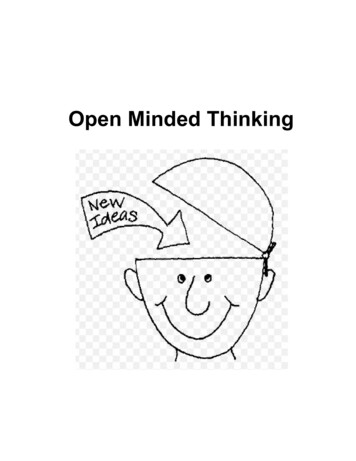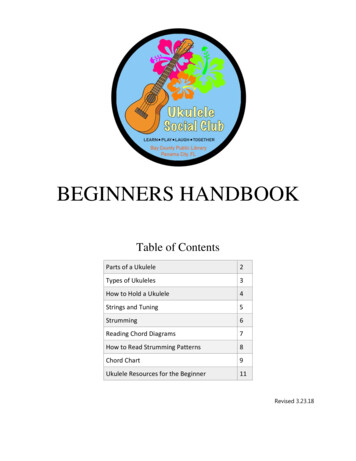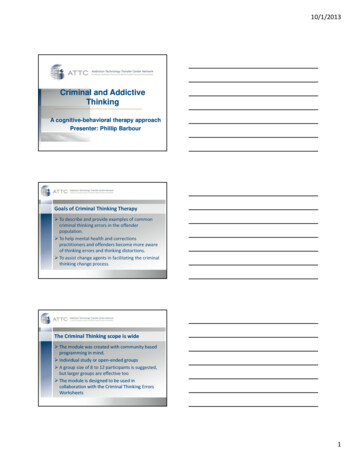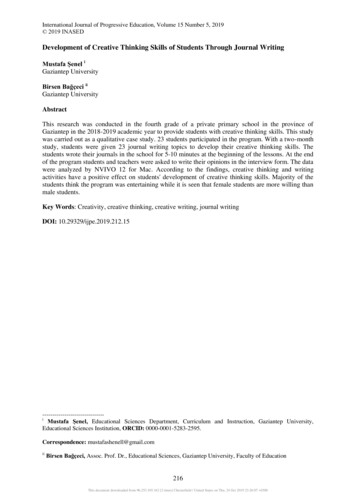
Transcription
Open Minded Thinking
“Dialectical”Open-mind thinking.Dialectical means that 2 ideas can both be true at the same time.There is always more than one TRUE way to see a situation and morethan one TRUE opinion, idea, thought, or dream.Two things that seem like (or are) opposites can both be true.All people have something unique, different, and worthy to teach us.A life worth living has both comfortable and uncomfortable aspects(happiness AND sadness; anger AND peace; hope ANDdiscouragement; fear AND ease; etc).All points of view have both TRUE and FALSE within them.Examples:You are right AND the other person is right.You are doing the best that you can AND you need to try harder, do better,and be more motivated to change.You can take care of yourself AND you need help and support from others.Being dialectical means:Letting go of self-righteous indignation.Letting go of “black and white”, “all or nothing” ways of seeing asituation.Looking for what is “left out” of your understanding of a situation.Finding a way to validate the other person’s point of view.Expanding your way of seeing things.Getting “unstuck” from standoffs and conflicts.Being more flexible and approachable.Avoiding assumptions and blaming.7
Guidelines for Dialectical ThinkingDo:Move away from “either-or” thinking to “BOTH-AND” thinking.Avoid extreme words: always never, you make me.Example:Instead of saying: “Everyone always treats me unfairly,” say“Sometimes I am treated fairly AND at other times I am treatedunfairly.”Practice looking at ALL sides of a situation/points of view.Find the “kernel of truth” in every side.Remember: NO ONE owns the truth. Be open and willing.If you feel indignant or outraged, you are NOT being dialectical.Use “I feel ” statements, instead of “You are ” statements.Accept that different opinions can be legitimate, even if you do not agree with them:“I can see your point of view even though I do not agree with it.”Don’t: assume that you know what others are thinking, check it out:“What did you mean when you said ?” expect others to know what you are thinking, be clear:“What I’m trying to say is ”8
Dialectics Homework SheetCircle the letter in front of the dialectical statement for each group ofsentences:1.a. It’s hopeless. Why even try? I give up.b. My problems are gone, this is easy.c. This is hard for me, and I’m going to keep working at it.2.a. I’m totally right about this—it’s the truth!b. I’m stupid. Everyone else is always right about things.c. Well, I can see it this way, and you see it that way.3.a. Everyone is always unfair to me.b. In some situations, I feel that I’m not being treated fairly.c. Everyone is always fair to me.4.a. People should listen to me whenever I need to talk.b. I should be able to handle my own problems without botheringother people.c. Sometimes I need someone to listen to me. When they can’t,it’s frustrating.5.a. It’s my parent’s fault that I have these problems, so Ishouldn’t have to work so hard to solve them.b. All of my problems are my own fault.c. I may not have caused all of my own problems, but I need tosolve them anyway.6.a. Other people always hurt me, so I don’t trust anyone.b. I trust some people and I find it very difficult to trust others.c. If I were healthy I would be able to trust everyone.7.a. I hate you for doing what you did. I am done being yourfriend.b. It shouldn’t be any big deal if other people hurt me.c. You really hurt my feelings and we will have to work it out.9
ValidationWhat is it?What is validation? It means telling someone that what they feel, think, believe, andreallogical understandableexperience is:Self-validation is when you are able to quietly reassure yourself that what you feelinside is real, is important, and makes sense.Emotions, thoughts, and sensations are all experiences that we sometimes doubt inourselves. We ask ourselves:DO I really feel this?SHOULD I feel this way? (Is it the “right” thing to feel, even if itinconveniences someone else?).We may look around us and try to guess what other people in the same situation feel,or what others EXPECT us to feel. This happens because we have been told at somepoint that we should not trust what our inner experience tells us. We actually trustother people MORE than ourselves.Sometimes when we self-invalidate, we spend a lot of time and energy trying to proveto others and ourselves that our experience is real, and makes sense. This often resultsin conflict or crisis.In DBT, we are learning to validate others because: it helps our relationships go better it calms intense situations so that we can problem solveWe learn to Self-Validate because: it quiets defensive/fearful emotions so we can problem solve. it allows us to let go of the pain and exhaustion that constantself-justification and self-doubt requires.Validation improves the quality of our lives.10
ValidationHow to do it?Validation does NOT mean that you AGREE or APPROVE of behavior.In fact, validation is non-judgmental.Validation Strategies:1. Focus on the inherent worth of the person, whether it is yourself orsomeone else.2. Observe—Listen carefully to what is said with words, expression, and body.Intently listen, be one-mindful in the moment.If you are self-validating, honor your experience by sitting quietly with it,knowing it for at least a few moments.If you are validating someone else, use good eye contact, nod, be one-mindful inyour focus on them.3. Describe—Non-judgmentally state the facts of the situation.4. State the unstated—Note the presence of feelings, beliefs, etc. that have notbeen voiced: “You seem to feel angry, but also hurt by what that person saidto you.”If validating yourself, identify primary emotions. If anger is obvious, explore yourfeelings of any shame, hurt, or disappointment that may be hiding beneath.5. Find what is true/valid about the experience and note this. Without feelingthat you have to agree or approve of the experience, find a piece of it thatmakes perfect sense, and validate this.If validating yourself, perhaps you realize that the thoughts you are having are“irrational”, however, validate that they exist and are powerful in the moment.If validating someone else, even if you disagree with their behavior, find somethingthat you can empathize with—“When you get that angry, you want to strike out atsomeone.”11
VALIDATION PRACTICEAfter reading each situation, circle all of the responses that are VALIDATING.Some of the responses may be skillful, but not validating. Remember to focus onreassuring self/other that their experience is real, important, and/or makes sense.Circle all of the validating responses for each question.1. A friend has just thrown a chair down the hallway because a peer refused to letthem use the phone. They have received a Major Infraction and are very angry. Theyare talking to you.a. You listen, nodding.b. You ignore them, because you don’t want to give them attention for badbehavior.c. You state, “You were really frustrated, weren’t you?”d. You say, “You’re right! She never lets anyone else use the phone!”2. A peer is having a lot of with symptoms lately. He is getting into trouble withstaff, breaking rules. He asks you to lie for him so that he can stay out of furthertrouble.a. You say, “You’re really worried about being in trouble, and Ican understand that, but I can’t lie, and get into trouble too.Let’s find another solution.”b. You immediately go tell staff on him.c. You try to avoid him. When he approaches you, you say, “I can’t talk rightnow, I have to do my laundry.”d. You say, “You want me to tell staff that you were with me and that youdidn’t do what they say you did.”3. You are feeling a lot of irritation and you don’t know why. You snap at a peerwho has done nothing wrong.a. You tell yourself, “I’m always irritable and drive people away.”b. You force yourself to behave more patiently with others than you actuallyfeel for the rest of the day.c. You talk to a friend and tell them, “I just snapped at someone, and I don’tknow why. I’m irritable and confused.”d. You ask for a PRN.12
Module #1Core Mindfulness Skills13
States of Mind14
Core Mindfulness Skills—WHAT SkillsTake hold of your mindObserve! Be curious about what you feel. Just notice how you feel, without trying to make feelings stronger, orweaker, go away, or last longer. See how long your feeling lasts, and if it changes. Notice how feelings flow in and out of your body like waves. What comes through your senses? Touch, smell, sight, sound, taste. Be like a non-stick pan, letting things slide off of your body and youremotions.Describe Use words to describe your experience. Use “fact” words, call a thought “just a thought”, call a feeling “just afeeling.” Use words that everyone would agree with. Don’t paint a colorful picture with words, or magnify a situation withwords. Try to avoid emotional words. Try to let go of your emotions about being “right” or about someoneelse being “wrong” while searching for words to describe.Participate Get “lost” in an activity. Let go of your sense of time while you are doing something. Allow yourself to be natural in the situation. Practice your skills until they become a part of you.15
Core Mindfulness--HOW SkillsPractice to use these all at the same timeNon-Judgmental Stance SEE, BUT DON’T EVALUATE. Take a non-judgmental stance. Just the facts.Focus on the “what”, not the “good” or “bad”, the “terrible”, the “should” or“should not”. UNGLUE YOUR OPINIONS from the facts, from the “who, what, when, andwhere. ACCEPT each moment, each event as a blanket spread out on the lawn acceptsboth the rain and the sun, each leaf that falls upon it. ACKNOWLEDGE the helpful, the wholesome, but don’t judge it. Acknowledgethe harmful, the unwholesome, but don’t judge it. When you find yourself judging, DON’T JUDGE YOUR JUDGING.One Mindfully in the Moment DO ONE THING AT A TIME. When you are eating, eat. When you arewalking, walk. When you are working, work. When you are in a group, or aconversation, focus your attention on the very moment you are in with theother person. Do each thing with all of your attention. If other actions, thoughts, or strong feelings distract you, LET GO OFDISTRACTIONS and go back to what you are doing—again, and again, andagain. CONCENTRATE YOUR MIND. If you find you are doing two things at once,stop and go back to one thing at a time.DescribeEffectively FOCUS ON WHAT WORKS. Do what needs to be done in each situation inorder to meet your larger goals. Stay away from thoughts of “right”, “wrong”,“should”, “should not”, “fair” and “unfair”. PLAY BY THE RULES. Act as skillfully as you can, meeting the needs of thesituation you are in, not the situation you WISH you were in. LET GO of vengeance, useless anger, and righteousness that hurts you anddoesn’t work.16
Observing and Describing ThoughtsPrompting Event:Feelings (and their intensity): Mad Sad GladScared AshamedList thoughts:Can you identify any MUSTS?Can you identify any SHOULDS about yourself?Can you identify any SHOULDS about others or the situation?Pick a “should” thought and change that to a non-judgmentalDESCRIBE:17
Noticing and Managing Thoughts that areJudgmental and IneffectiveSituation:Emotion Mind Thoughtsabout the situationMood:Rational Mind Choices1.Urge:Give no more than twowords to describemood and rate each 1100:2.Give no more than twowords to describeurges and rate each 1100:3.Rational Mind beliefsabout the situationRational Mind Choices(use Describe and NJS)Wise Mind Response1.1.1.2.2.2.3.3.3.Mood:Give no more than two words todescribe mood and rate the intensityof each feeling from 1-100:Urge:Give no more than two words todescribe mood and rate the intensityof each feeling from 1-100:18
Module #2Interpersonal EffectivenessSkills19
Goals of Interpersonal EffectivenessOBJECTIVES EFFECTIVENESS:Getting the “thing” I wantWhen it’s your legitimate right.Getting another to do something for you.Refusing an unwanted or unreasonable request.Resolving an interpersonal conflict.Getting your opinion or point of view taken seriously.QUESTIONS1. What is the “thing” that I want from this interaction?2. What do I have to do to get the results? What will work?RELATIONSHIP EFFECTIVENESS:Getting and Keeping a Good RelationshipActing in such a way that the other person keeps liking and respecting you.Balancing immediate goals with the good of the long –term relationship.Remembering why the relationship is important to you now and in the future.QUESTIONS1. How do I want the other person to feel about me after the interaction?2. What do I have to do to get (keep) this relationship?SELF-RESPECT EFFECTIVENESS:Keeping or Improving Self-Respect and Liking for YourselfRespecting your own values and beliefs: acting in a way that makes you feelmoral.Acting in a way that makes you feel capable and effective.QUESTIONS1. How do I want to feel about myself after the interaction is over?2. What do I have to do to feel that way about myself? What will work?20
Guidelines for Objectives Effectiveness:Getting What You WantA way to remember these skills in to remember the term ANAPPEAR CONFIDENTNEGOTIATEDescribeDescribe the current SITUATION (if necessary).Tell the person exactly what you are reacting to. Stick to the facts.ExpressExpress your FEELINGS and OPINIONS about the situation.Assume that your feelings and opinions are not self-evident. Give a briefRationale. Use phrases such as “I want”, “I don’t want,” instead of “Ineed,” “you should,” or “I can’t.”AssertAssert yourself by ASKING for what you want or SAYING NO clearly.Assume that others will not figure it out or do what you want unless you ask.Assume that others cannot read your mind. Don’t expect others to know howhard it is for you to ask directly for what you want.ReinforceReinforce or reward the person ahead of time by explaining theCONSEQUENCES.Tell the person the positive effects of getting what you want or need.Tell him or her (if necessary) the negative effects of your not getting it.Help the person feel good ahead of time for doing or accepting what youwant.Reward him or her afterwards.(Continued)21
OBJECTIVES EFFECTIVENESS (Cont.)(stay) MindfulKeep you focus ON YOUR OBJECTIVES.Maintain your position. Don’t be distracted.“Broken Record”Keep asking, saying no, or expressing your opinion over and overand over. Keep your voice calm and even while doing this.IgnoreIf another person attacks, threatens, or tries to change the subject,Ignore the threats, comments, or attempts to divert you. Don’trespond to attacks. Ignore distractions. Just keep making yourpoint.Appear ConfidentAppear EFFECTIVE and competent.Use a confident voice tonen and physical manner; make good eyecontact. No stammering, whispering, staring at the floor,retreating, saying “I’m not sure,” etc.NegotiateBe willing to GIVE to GET. Offer and ask for alternative solutionsto the problem. Reduce your request. Maintain no, but offer to dosomething else or to solve the problem another way. Focus on whatwill work.Turn the tablesTurn the problem over to the other person. Ask for alternativesolutions:“What do you think we should do?” “I’m not able to say yes, andyou seem to really want me to. What can we do here?” “How canwe solve this problem?”22
Asking for What I Want or Refusing a Request“DEAR MAN”Describe the current situation. Tell the person exactly what you are reacting to. Stick to the facts.Express your feelings and opinions about the situation. Assume that others cannot read your mind.Don’t expect others to know how hard it is for you to ask directly for what you want.Assert yourself by asking for what you want or saying no clearly. Assume that others cannot readyour mind. Don’t expect others to know how hard it is for you to ask directly for what you want.Reinforce the reward to the person ahead of time. Tell the person the positive effects of gettingwhat you want or need. Help the person feel good ahead of time for doing what you want.Mindfully keep your focus on your objectives. Maintain your position. Don’t be distracted.Appear Confidant Use a confidant voice tone and physical manner; make good eye contact. Nostammering, whispering, staring at the floor, retreating, saying “I’m not sure,” etc.Negotiate by being willing to give to get. Offer and ask for alternative solutions to the problem.What am I willing to “settle for” or “give up” in order to gain what I want in the situation?23
Guidelines for Relationship EffectivenessKeeping the RelationshipA way to remember these skills is to remember the word “GIVE” (DEAR MAN, GIVE):(Be) Gentle(Act) InterestedValidate(Use an) Easy Manner(Be) GentleBe courteous and temperate in your approach.No attacksNo verbal or physical attacks. No hitting, clenching fists.Express anger directly.No threatsNo “manipulating” statements, no hidden threats. No “I’ll killmyself in you ” Tolerate a no to requests. Stay in thediscussion even if it gets painful. Exit gracefully.No judging(Act) InterestedNo moralizing. No “if you were a good person, you would ,”No “you should ,” “You shouldn’t ”LISTEN and be interested in the other person.Listen to the other person’s point of view, opinion, reasonsfor saying no, or reasons for making a request of you. Don’tinterrupt, talk over, etc. Be sensitive to the other person’sdesire to have the discussion at a later time. Be patient.Validate(Use an) Easy mannerValidate or ACKNOWLEDGE the other person’s feelings,wants, difficulties, and opinions about the situation. Benonjudgmental out loud: “I can understand how you feel,but ”, “I see that you are busy, and ”Use a little humor. SMILE. Ease the person along. Belight-hearted. Wheedle. Use a “soft sell” over a “hardsell.” Be political.24
Guidelines for Self-Respect Effectiveness:Keeping Your Respect for YourselfA way to remember this is the word “FAST” (DEAR MAN, GIVE FAST):(Be) FairBe fair to YOURSELF and to the OTHER person.(No) ApologiesNo OVERLY apologetic behavior. No apologizing for being alive,for making a request at all. No apologizing for having an opinion,for disagreeing.Stick to valuesStick to YOUR OWN values.(be) TruthfulDON’T LIE, ACT HELPLESS when you are not, or EXAGGERATE.Don’t make up excuses.25
GOALS AND PRIORITIES IN INTERPERSONAL SITUATIONSName DateUse this sheet to figure out your goals and priorities in any situation that creates a problem foryou such as ones where: 1) your rights or wishes are not being respected, 2) you want someoneto do or change something or give you something, 3) you want or need to say no or resistpressure to do something, 4) you want to get your positon or point of view taken seriously, and5) there is conflict with another person. Observe and describe in writing as close in time to thesituation as possible. Write on the back of the page if you need more room.Prompting Event for my problem: Who did what to whom? What led up to what?What is it about this situation that is a problem for me?My WANTS and DESIRES in this situation:OBJECTIVES: What specific results do I want? What changes do I want theperson to make?RELATIONSHIP: How do I want the other person to feel about me after theinteraction?SELF-RESPECT: How do I wan tto feel about myself after the interaction?My PRIORITIES in this situation: Rate priorities 1 (most important), 2 (second most important),and 3 (least important).OBJECTIVES RELATIONSHIP SELF-RESPECTCONFLICTS IN PRIORITIES that make it hard to be effective in this situation?26
FACTORS REDUCINGINTERPERSONAL EFFECTIVENESSLACK OF SKILLYou actually DON’T KNOW what to say or how to act. You don’t know how you shouldbehave to achieve your objectives. You don’t know what will work.MYTHS THAT CONFUSE YOUYou know what to say or do in order to be effective, but habits in the way that you thinkincrease your emotions about the situation and cloud your vision of the effective choice. Myth: Everyone must like me. (What if people don’t like me?!) Myth: I am not a good enough person to deserve good things. Myth: I have to do everything right or I’m stupid/incompetent.EMOTION MINDThe strength of your emotions (ANGER, SADNESS, FEAR, GUILT) gets in the way ofyour ability to act effectively. You have the ability, but your emotions make you unableto do or say what you want. Emotions, instead of skill, control what you say and do.INDECISIONYou CAN’T DECIDE what to do or what you really want. You have the ability, but yourindecision gets in the way of doing or saying what you want. You are ambivalent aboutyour priorities. You can’t figure out how to balance: Asking for too much versus not asking for anything. Saying no to everything versus giving in to everything.ENVIRONMENTCharacteristics of the environment make it impossible for even a very skilled person to beeffective. SKILLFUL BEHAVIOR DOESN’T WORK. Other people are too powerful. Other people will be threatened or have some other reason for notliking you if you get what you want. Other people won’t give you what you need or let you say no withoutpunishing you unless you sacrifice your self-respect, at least a little.27
MYTHS ABOUT INTERPERSONALEFFECTIVENESSPut a check mark in the box next to each of the statements below that seem “true” in youremotion mind, rational mind, or wise mind.1. If I say and do the correct things, people will like me. If people don’t like me, it’sprobably because I have done something bad or wrong.CHALLENGE:2. I can’t stand it if someone gets upset with me.CHALLENGE:3. I don’t deserve to get what I want or need.CHALLENGE:4. If I make a request, this will show that I am a very weak person.CHALLENGE:5. I must be really inadequate if I can’t fix this myself.CHALLENGE:6. I have to know whether a person is going to say yes before I make a request.CHALLENGE:7. Making requests is really pushy (bad, self-centered, selfish, un-Christian).CHALLENGE:8. It doesn’t make any difference: I don’t care really.CHALLENGE:9. Obviously, the problem is just in my head. If I would just think differently Iwouldn’t have to bother everybody else.CHALLENGE:10. This is a catastrophe (is really bad, is terrible, is driving me crazy, will destroyme, is a disaster).CHALLENGE:11. Saying no to a request is always a selfish thing to do.CHALLENGE:12. I should be willing to sacrifice my own needs for others.CHALLENGE:13. Other:CHALLENGE:14. Other:CHALLENGE:28
SELF-ENCOURAGEMENTREALITY STATEMENTSFOR INTERPERSONAL EFFECTIVENESS1. It is OK to want or need something from someone else.2. I have a choice to ask someone for what I want or need.3. I can stand it if I don’t get what I want or need.4. The fact that someone says no to my request doesn’t mean I should not have asked inthe first place.5. If I didn’t get my objectives, that doesn’t meant I didn’t go about it in a skillful way.6. Standing up for myself over “small” things can be just as important as “big” things areto others.7. I can insist upon my rights and still be a good person.8. I sometimes have a right to assert myself, even though I may inconvenience others.9. The fact that other people might not be assertive doesn’t mean that I shouldn’t be.10. I can understand and validate another person, and still ask for what I want.11. There is no law that says other people’s opinions are more valid than mine.12. I may want to please people I care about, but I don’t have to please them all the time.13. Giving, giving, giving is not the be-all of life. I am an important person in this world,too.14. If I refuse to do a favor for people, that doesn’t mean I don’t like them. They willprobably understand that, too.15. I am under no obligation to say yes to people simply because they ask a favor of me.16. The fact that I say no to someone does not make me a selfish person.17. If I say no to people and they get angry, that does not mean that I should have said yes.18. I can still feel good about myself, even though someone else is annoyed with me.OTHERS:29
OBSERVING AND DESCRIBING INTERPERSONAL SITUATIONSName: Date:Fill out this sheet during or just after a situation that creates a problem for you such as one where:1) your rights or wishes are not being respected, 2) you want someone to do or change somethingor give you something, 3) you want or need to say no or resist pressure to do something, 4) youwant to get your position or point of view taken seriously, and 5) there is conflict with anotherperson. Observe and describe in writing as close in time to the situation as possible. Write on theback of this page if you need more room.PROMPTING EVENT for my problem? Who did what to whom? What led up to what?What I SAID OR DID in the situation: (Be SPECIFIC.)Rate INTENSITY of response.Intensity-rating (0-6):FACTORS REDUCING MY EFFECTIVENS in this situation:SKILLS LACKING: (What don’t I know how to do or say?AUTOMATIC THOUGHTS OR MYTHS:EMOTIONS INTERFERINGINDECISION (or conflict in goals) getting in the way:OBJECTIVES: What results to I want? What changes do I want the person to make?RELATIONSHIP: How do I want other person to feel about me after the interaction?SELF-RESPECT: How do I want to feel about myself after the interaction?CONFLICT or INDECISIONENVIRONMENTAL FACTORS getting in my way:30
Expressing Emotions EffectivelyPractice skillfully observing and describing your feelings about the following situations thatyou might experience with a staff member, a peer, a friend, or a family member.Remember to focus on what YOU experience, not what the other person has done, or mightbe feeling.1. You feel ignored by a favorite staff member. They always seem to have time for others.2. Your therapist (or visitor) is late.3. Your roommate leaves dirty clothes on the floor which results in you failing your roomand appearance check.4. A peer calls you a name or insults you in some way.5. Your own example- any situation where you need to express your emotions to someoneelse.31
GUIDELINES FOR SHARING AND LISTENINGSkills for sharing emotions:1.2.3.4.5.State your views as your own feelings and thoughts, not as absolutetruths.When expressing negative emotions or concerns, also include any positivefeelings you have about the person or situation.Make your statement as specific as possible, both in terms of specificemotions and thoughts.Speak in “paragraphs”. That is, express one main idea with someelaboration and then allow the other person to respond. Speaking for along time without a break makes it hard for someone to listen.Express your feelings and thoughts with tact and timing so that theperson can listen to what you are saying without becoming defensive.Skills for listening:Ways to respond while the other person is speaking:1. Show that you understand the person’s statements and accept his or herright to have those thoughts and feelings. Demonstrate this acceptancethrough your tone of voice, facial expressions, and posture.2. Try to put yourself in the other person’s place and look at the situation fromhis or her perspective in order to determine how the other person feels andthinks about the issue.Skills for Responding:Ways to respond after the other person finishes speaking:1. After the person finishes speaking, summarize and restate their mostimportant feelings, desires, conflicts, and thoughts.2. While in the listener role, do not:a. Ask questions, except for clarification.b. Express your own viewpoint or opinion.c. Interpret or change the meaning of person’s statements.d. Offer solutions or attempt to solve a problem if one exists.e. Make judgments or evaluate what the person has said.32
Extra Skills for Solving Conflicts with Others1. Describe: Clearly and specifically state what the problem is.a. Phrase the problem in terms of behaviors that are currently occurring or not occurring.b. Break large, complex problems down into several smaller problems, and deal with themone at a time.c. Make certain that both people agree on the statement of the problem and are willing todiscuss it.2. Express: Clarify why the issue is important to you.a. Clarify why the issue is important to you and provide your understanding of the issuesinvolved.b. Explain what your desires are that you would like to see taken into account in the solution;do not offer specific solutions at this time.3. Assert: Discuss possible solutions.a. Stay solution-oriented; your goal is not to defend yourself, decide who is right or wrong,or establish the truth regarding what happened in the past.b. Your goal is to decide how to do things differently in the future.c. If you tend to get focused on a single or a limited number of alternatives, considerbrainstorming (generating a variety of possible solutions in a creative way).4. Negotiate: Decide on a solution that is agreeable to both of you.a. If you cannot find a solution which greatly pleases both partners, suggest acompromise solution.b. State your solution in clear, specific, behavioral terms.c. After agreeing on a solution, have one partner restate the solution.d. Do not accept a solution on which you do not intend to follow through.e. Do not accept a solution which you believe will make you angry or resentful.5. Decide on a trial period to implement the solution.a. Allow for several attempts of the new solution.b. Review the solution at the end of the trial period.33
Choices About IntensityIf you always are at maximum intensity, people will stoplistening to you. Use maximum volume rarely.HIGH INTENSITY: TRY AND CHANGE THE SITUATIONAsk firmly, insist 6 Refuse firmly, don’t give in.Ask firmly, resist no 5 Refuse firmly, resist giving in.Ask firmly, take no 4 Refuse firmly, but reconsiderAsk tentatively, take no 3 Express unwillingnessHint openly, take no 2 Express unwillingness, but say yesHint indirectly 1 Express hesitancy, say yesDon’t ask, Don’t hint 0 Do what other wants witho
Letting go of self-righteous indignation. Letting go of “black and white”, “all or nothing” ways of seeing a situation. Looking for what is “left out” of your understanding of a situation. Finding a way to validate the other person’s point of view. Expanding your way o










